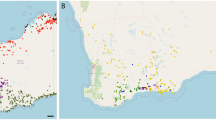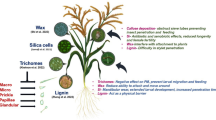Abstract
The fungal pathogen Didymella bryoniae causes gummy stem blight and black rot on a broad spectrum of cucurbits. However the substantial differences in susceptibility among Cucurbitaceae are not well studied. Susceptibility was characterized with muskmelon (Cucumis melo), watermelon (Citrullus lanatus), cucumber (Cucumis sativus), pumpkin (Cucurbita pepo), and zucchini (C. pepo). Lesion diameters on leaf disks inoculated with agar plugs were measured 7 days after inoculation, and the necrotized areas of leaf disks inoculated with conidial suspensions were measured 48 h after inoculation (hai). For each species, the number of trichomes was counted on 16 leaf pieces using a stereomicroscope. Lengths of ≥21 trichomes per species were measured. Polyphenol autofluorescence was recorded at 48 hai and quantified. Watermelon had the lowest trichome density and the shortest trichomes. Zucchini showed the highest trichome density, and pumpkin had the longest trichomes. Trichome density was negatively correlated with mean necrotized leaf area, and trichome length was highly negatively correlated with lesion diameter. Mean fluorescing area was correlated with lesion diameters and mean necrotized leaf area. This is the first study in which trichome morphology and polyphenol autofluorescence in inoculated cucurbit leaves were correlated with susceptibility to D. bryoniae.



Similar content being viewed by others
References
Adebooye, O. C., Hunsche, M., Noga, G., & Lankes, C. (2012). Morphology and density of trichomes and stomata of Trichosanthes cucumerina (Cucurbitaceae) as affected by leaf age and salinity. Turkish Journal of Botany, 36, 328–335.
Beckman, C. H., Mueller, W. C., & MacHardy, W. E. (1972). Localization of stored phenols in plant hairs. Physiological Plant Pathology, 2, 69–74.
Beckman, C. H. (2000). Phenolic-storing cells: Keys to programmed cell death and periderm formation in wilt disease resistance and in general defense responses in plants? Physiological and Molecular Plant Pathology, 57, 101–110.
Blancard, D., Lecoq, H., & Pitrat, M. (1994). A colour atlas of cucurbit diseases observation, identification and control (English ed.). Limoges: Manson Publishing Ltd.
Chiu, W. F., & Walker, J. C. (1949). Physiology and pathogenicity of the cucurbit black-rot fungus. Journal of Agricultural Research, 78, 589–615.
Daayf, F., Bel-Rhlid, R., & Bélanger, R. R. (1997). Methyl ester of p-coumaric acid: a phytoalexin-like compound from long English cucumber leaves. Journal of Chemical Ecology, 23, 1517–1526.
Daayf, F., Schmitt, A., & Bélanger, R. R. (1997). Evidence of phytoalexins in cucumber leaves infected with powdery mildew following treatment with leaf extracts of Reynoutria sachalinensis. Plant Physiology, 113, 719–727.
Daayf, F., Ongena, M., Boulanger, R., Hadrami, I. E., & Bélanger, R. R. (2000). Induction of phenolic compounds in two cultivars of cucumber by treatment of healthy and powdery mildew-infected plants with extracts of Reynoutria sachalinensis. Journal of Chemical Ecology, 26, 1579–1593.
Dos Santos, G. R., da Silva, Alvares, Velloso Ferreira, M., de Pinho, Caldas, Pessoa-Filho, M. A., Ferreira, M. E., et al. (2009). Host specificity and genetic diversity of Didymella bryoniae from cucurbitaceae in Brazil. Journal of Phytopathology, 157, 265–273.
Farr, D. F., & Rossman, A. Y. (2014). Fungal databases. Systematic Mycology and Microbiology Laboratory, ARS, USDA. http://nt.ars-grin.gov/fungaldatabases/
Fawe, A., Abou-Zaid, M., Menzies, J. G., & Bélanger, R. R. (1998). Silicon-mediated accumulation of flavonoid phytoalexins in cucumber. Phytopathology, 88, 396–401.
Giordani, E., Padula, G., & Radice, S. (2013). Compared anatomy of young leaves of Prunus persica (L.) Batsch with different degrees of susceptibility to Taphrina deformans (Berk.) Tul. Journal of Phytopathology, 161, 190–196.
Gradziel, T. M., Thorpe, M. A., Bostock, R. M., & Wilcox, S. (1998). Breeding for brown rot (Monilinia fructicola) resistance in clingstone peach with emphasis on the role of fruit phenolics. Acta Horticulturae, 465, 161–170.
Grossenbacher, J. G. (1909). A Mycosphaerella wilt of melons. New York Agricultural Experiment Station Technical Bulletin, 9, 193–229.
Grube, M., Fürnkranz, M., Zitzenbacher, S., Huss, H., & Berg, G. (2011). Emerging multi-pathogen disease caused by Didymella bryoniae and pathogenic bacteria on Styrian oil pumpkin. European Journal of Plant Pathology, 131, 539–548.
Inamdar, J. A., & Gangadhara, M. (1975). Structure, ontogeny, classification and organographic distribution of trichomes in some Cucurbitaceae. Feddes Repertorium, 86, 307–320.
Keinath, A. P. (2011). From native plants in Central Europe to cultivated crops worldwide: The emergence of Didymella bryoniae as a cucurbit pathogen. HortScience, 46, 532–535.
Keinath, A. P. (2014). Differential susceptibility of nine cucurbit species to the foliar blight and crown canker phases of gummy stem blight. Plant Disease, 98, 247–254.
Keinath, A. P. (2014). Reproduction of Didymella bryoniae on nine species of cucurbits under field conditions. Plant Disease, 98, 1379–1386.
Kolb, C. A., Käser, M. A., Kopecký, J., Zotz, G., Riederer, M., & Pfündel, E. E. (2001). Effects of natural intensities of visible and ultraviolet radiation on epidermal ultraviolet screening and photosynthesis in grape leaves. Plant Physiology, 127, 863–875.
Laźniewska, J., Macioszek, V. K., & Kononowicz, A. K. (2012). Plant-fungus interface: The role of surface structures in plant resistance and susceptibility to pathogenic fungi. Physiological and Molecular Plant Pathology, 78, 24–30.
Li, J., Zhao-Hui, C., Batoux, M., Nekrasov, V., Roux, M., Chinchilla, D., et al. (2009). Specific ER quality control components required for biogenesis of the plant innate immune receptor EFR. Proceedings of the National Academy of Sciences of the United States of America, 106, 15973–15978.
Luna, E., Pastor, V., Robert, J., Flors, V., Mauch-Mani, B., & Ton, J. (2011). Callose deposition: A multifaceted plant defense response. Molecular Plant-Microbe Interactions, 24, 183–193.
Mayer, A. M. (2006). Polyphenol oxidases in plants and fungi: Going places? A review. Phytochemistry, 67, 2318–2331.
Menendez Sevillano, M. C., D’Ambrogio, A., Panadero Pastrana, C., & Sierra, E. (1997). Resistance to rust caused by foliar pubescence in Argentinean common bean cultivars. Annual Report of the Bean Improvement Cooperative, 40, 108–109.
Misra, A. N., Misra, M., & Singh, R. (2012). Chlorophyll fluorescence in plant biology, Biophysics, Dr. Prof. Dr. A.N. Misra ed., InTech, Available at: http://www.intechopen.com/books/ biophysics/chlorophyll-fluorescence-in- plant-biology
Mmbaga, M. T., & Steadman, J. R. (1990). Adult plant rust resistance and leaf pubescence on dry beans. Annual Report of the Bean Improvement Cooperative, 33, 61–62.
Nonomura, T., Xu, L., Wada, M., Kawamura, S., Miyajima, T., Nishitomi, A., et al. (2009). Trichome exudates of Lycopersicon pennellii form a chemical barrier to suppress leaf-surface germination of Oidium neolycopersici conidia. Plant Science, 176, 31–37.
Oberhollenzer, K., Seigner, E., Eichmann, R., & Hückelhoven, R. (2013). Technique to assess gene function in hop (Humulus lupulus L.)—powdery mildew interactions. Acta Horticulturae, 1010, 59–66.
Salazar, S. M., Castagnaro, A. P., Arias, M. E., Chalfoun, N., Tonello, U., & Díaz Ricci, J. C. (2007). Induction of a defense response in strawberry mediated by an avirulent strain of Colletotrichum. European Journal of Plant Pathology, 117, 109–122.
Skadsen, R. W., & Hohn, T. M. (2004). Use of Fusarium graminearum transformed with gfp to follow infection patterns in barley and Arabidopsis. Physiological and Molecular Plant Pathology, 64, 45–53.
Treutter, D., & Feucht, W. (1990). The pattern of flavan-3-ols in relation to scab resistance of apple cultivars. Journal of Horticultural Science, 65, 511–517.
Van Steekelenburg, N. A. M. (1983). Epidemiological aspects of Didymella bryoniae, the cause of stem and fruit rot of cucumber. Netherlands Journal of Plant Pathology, 89, 75–86.
Zaiter, H. Z., Coyne, D. P., Steadman, J. R., & Beaver, J. S. (1990). Inheritance of abaxial leaf pubescence in beans. Journal of the American Society for Horticultural Science, 115, 158–160.
Zelinger, E., Hawes, C. R., Gurr, S. J., & Dewey, F. M. (2006). Attachment and adhesion of conidia of Stagonospora nodorum to natural and artificial surfaces. Physiological and Molecular Plant Pathology, 68, 209–215.
Acknowledgments
We thank Gero Barmeier, Chair of Plant Nutrition, Technische Universität München, for his help with photo-analysis.
Author information
Authors and Affiliations
Corresponding author
Rights and permissions
About this article
Cite this article
Rennberger, G., Keinath, A.P. & Hess, M. Correlation of trichome density and length and polyphenol fluorescence with susceptibility of five cucurbits to Didymella bryoniae . J Plant Dis Prot 124, 313–318 (2017). https://doi.org/10.1007/s41348-016-0050-z
Received:
Accepted:
Published:
Issue Date:
DOI: https://doi.org/10.1007/s41348-016-0050-z




